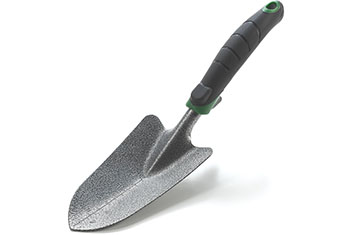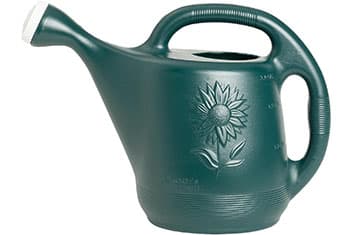Sunflowers are a bright and cheery plant that grow well in most locations and environments. Some gardeners that want to get a jump start on the growing season or just need to thin their garden will transplant sunflowers from pots, a nursery or into a different garden.
Keep reading to learn how to replant sunflowers, the best time of year to move, the necessary gear plus a few tips and tricks for growing perennial sunflower, dwarf sunflower, giant sunflower and even growing indoor sunflowers!
Necessary Gear


A Small Shovel
The Edward Tools Garden Trowel is a heavy-duty hand shovel made of carbon steel, which is stronger than stainless steel and designed for confident digging in tough conditions like heavy clay or rocky soils. It features an ergonomic grip for comfortable use and depth marker measurements for consistent planting or transplanting.

A Watering Can
This Watering Can offers a generous 2-gallon capacity, reducing the frequency of refills and allowing you to focus more on caring for your plants. Made in the USA from thick-walled, UV-resistant, and BPA-free plastic, this hunter green can is both durable and environmentally friendly, featuring a detachable nozzle for easy cleaning and an ergonomic handle for comfortable pouring.
Step by Step Sunflower Transplanting Guide
Our garden experts put together an 6 step guide with a few tips and tricks to make transplanting your sunflowers a success. Our guide will help you pick the right time of year, remove the plants then replant them without hurting the plant.
Step 1: Dig Circle Around Stalk
Start by digging a circle around each plant. Dig deep enough that you can reach under the root ball and scoop it out.
Step 2: Remove Seedlings from Pot
If you started the growing season early using an indoor planter you can loosen the sunflowers from the side by getting the soil wet and gently scooping it from the pot. Don’t let the plant get too tall or it won’t be able to be replanted outside.
Step 3: Dig New Holes
Find a new home for the flowers and dig a hole 10 inches deep. If you are moving multiple plants dig each hole at least 12 inches apart so the flowers have room to grow.
Step 4: Prepare the Flowerbed
Find a new home for the flowers and dig a hole 10 inches deep. If you are moving multiple plants dig each hole at least 12 inches apart so the flowers have room to grow.
Step 5: Place Flowers
Place each sunflower into the holes and cover with dirt until it is level with the ground. If the plants are large you may need to set up supports so it does not fall over when the wind blows. It is also a good idea to cover the soil with a layer of mulch to prevent soil run off when it rains
The best area to replant sunflowers is in an area with direct sunlight that gets plenty of water.
Step 6: Water the Garden
After all the sunflowers have been replanted water the garden enough to make the soil damp. Make sure not to over water or you could wash away valuable soil or introduce root rot to the plants.
When to Transplant Sunflowers
The best time of year to transplant sunflowers is when the weather is warm outside and the plants are about 6″ tall. If you started growing indoors in a pot you can replant at the start of the summer.
Transplanting Sunflowers from Pots
Many gardeners start their sunflowers using a seed tray indoors to start the seedlings then later transplant them outside for the tallest sunflowers. Transplanting a sunflower from a pot will work most of the time – just make sure the soil is rich with compost and regularly watered.
Sunflowers and Transplant Shock
Transplant shock in sunflowers can be a significant concern, but it’s entirely avoidable with the right precautions. The key to preventing transplant shock lies in minimizing the disturbance to the plant’s root system during the process. Start by watering the sunflowers thoroughly a few hours before the transplant.
This ensures the roots are well-hydrated and more resilient to the stress of being moved. When you’re ready to transplant, dig a wide berth around the sunflower to avoid damaging the roots. The new location should be prepared ahead of time, with a hole that’s twice as wide and just as deep as the root ball.
Once transplanted, water the sunflower immediately and keep the soil consistently moist for the first few weeks. This helps the plant recover and establish itself in its new location. Remember, the goal is to provide a smooth transition for the sunflower, reducing the shock and promoting a successful transplant.
Frequently Asked Questions
Can your transplant sunflowers?
Yes. Large sunflowers and seedlings can be successfully transplanted and re-potted.
How deep are the roots of a sunflower?
Seedlings roots only go a few inches deep but full grown plants can have root balls that go 3 feet deep.
Can you transplant large sunflowers?
Large sunflowers can be transplanted but you need to select the location carefully to avoid shock. The larger the plant the more difficult it is to transplant sunflowers.
Related Posts
How to transplant palm trees
How to transplant mint
